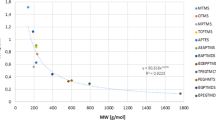Abstract
Wood was treated with three different alkoxysilanes which are able to undergo a sol–gel process: tetraethoxysilane (TEOS), methyl triethoxysilane (MTES) and propyl triethoxysilane (PTEO). Two types of treatments were compared: impregnation of fibre saturated wood with monomeric silane solutions, and impregnation with pre-hydrolysed partly oligomeric silanes. Wood properties such as cell wall bulking, anti-swelling efficiency (ASE), moisture uptake and durability were more significantly improved in samples treated with monomeric silanes than in samples treated with oligomeric silanes. SEM-EDX mapping showed that this treatment resulted in a higher degree of silicon incorporation into the cell wall, although the weight percent gain (WPG) was lower compared to the treatment with pre-hydrolysed partly oligomeric silanes. The resistance against soil micro-organisms was enhanced in the initial phase of incubation especially in those samples treated with organo-functional-alkoxysilanes. In miniaturised block tests with the white-rot basidiomycete Trametes versicolor, an improved durability was observed within the test period. During an air conditioning step, a weight loss of the treated samples occurred which was accompanied by a reduction in bulking and ASE. The initial reduction of moisture uptake observed after treatment diminished almost completely. This effect was explained by an ageing of the gels in the wood cell wall which is a consequence of uncompleted hydrolysis and condensation of the silanes during the treatment.





Similar content being viewed by others
References
Böttcher H, Jagoda C, Trepte J, Kallies K-H, Haufe H (1999) Sol-gel composite films with controlled release of biocides. J Control Release 60:57–65
Bravery AF (1978) A miniaturised wood-block test for rapid evaluation of wood preservative fungicides. Doc. No. WP 2113, IRG International Research Group on Wood Preservation, Stockholm
Brinker CF, Scherer GW (1990) Sol-gel-science. Academic, San Diego
Bücker M, Böcker W, Unger B (2001) Entwicklung von umweltverträglichen Holzverbundwerkstoffen mit verbesserter biologischer und Feuchtebeständigkeit. In: Wielage B, Leonhardt G (eds) Verbundwerkstoffe und Werkstoffverbunde. Wiley-VCH, Weinheim, pp 463–467
Machek L, Militz H, Sierra-Alvez R (2001) The use of an acoustic technique to assess wood decay in laboratory soil-bed tests. Wood Sci Technol 34:467–472
Militz H, Beckers EPJ, Homan WJ (1997) Modification of solid wood: research and practical potential. Doc. No. WP 40098, IRG International Research Group on Wood Preservation, Stockholm
Norimoto M (2001) Chemical modification of wood. In: Hon DNS, Shiraishi N (eds) Wood and cellulosic chemistry, 2nd edn. Dekker, New York, pp 573–598
Ogiso K, Saka S (1993) Wood-inorganic composites prepared by sol-gel process. II. Effects of ultrasonic treatments on preparation of wood-inorganic composites. Mokuzai Gakkaishi 39:301–307
Reinsch S, Böcker W, Bücker M, Seeger S, Unger B (2002) Development of wood-inorganic composites with enhanced properties and environmental stability. Presented at the 4th international wood and fibre symposium, Kassel, Germany, 10–11 April
Rowell RM (1983) Chemical modification of wood. Forest Prod Abstr 6:363–382
Saka S, Ueno T (1997) Several SiO2 wood-inorganic composites and their fire-resisting properties. Wood Sci Technol 31:457–466
Saka S, Sasaki M, Tanahashi M (1992) Wood-inorganic composites prepared by sol-gel processing I. Wood-inorganic composites with porous structure. Mokuzai Gakkaishi 38:1043–1049
Scheithauer M, Swaboda C, Böttcher H, Trepte J (1998) Möglichkeiten des Einsatzes von Siliciumdioxid-Solen als Holzveredelungsmittel. In: Biologischer/Biotechnologischer Holzschutz. Proceedings of the meeting of the Deutsche Bundesstiftung Umwelt, Osnabrück, Germany, 9 September 1998
Acknowledgements
We express our gratitude to Degussa AG for their financial support and fruitful discussions.
Author information
Authors and Affiliations
Corresponding author
Rights and permissions
About this article
Cite this article
Donath, S., Militz, H. & Mai, C. Wood modification with alkoxysilanes. Wood Sci Technol 38, 555–566 (2004). https://doi.org/10.1007/s00226-004-0257-1
Received:
Published:
Issue Date:
DOI: https://doi.org/10.1007/s00226-004-0257-1




